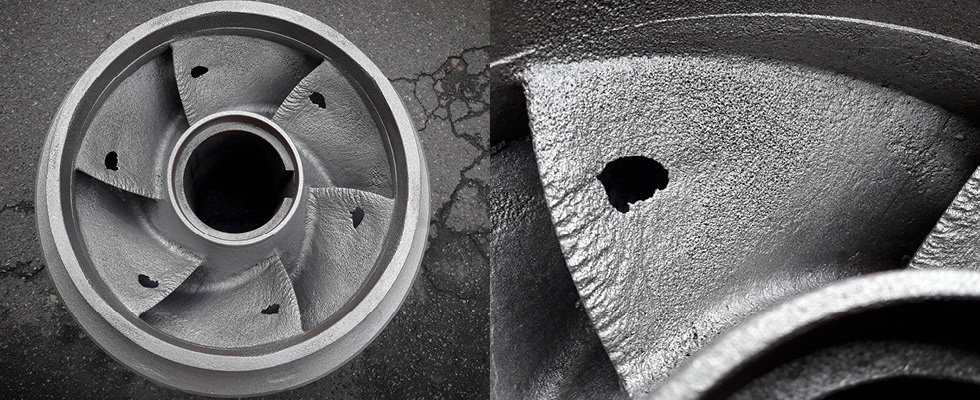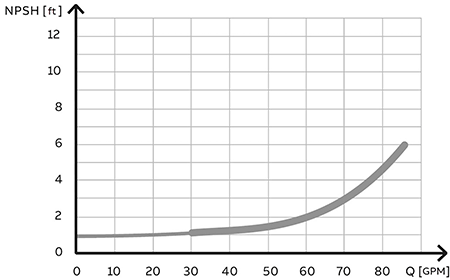
In this Pumps 101 article, learn what cavitation is, the causes and timing behind why it happens, the damage it can inflict on pumps and ways to avoid it. The 201 article will more comprehensively discuss the scientific factors triggering cavitation, methods for detection and multiple effective strategies to mitigate its effects, including using a drive to control the pump.
What Is Cavitation & Why Does It Occur?
Cavitation can occur in centrifugal pumps for various reasons. One of those reasons is when the inlet pressure to a pump is low. Low inlet pressure can occur due to a low level of liquid in a tank that supplies the liquid to a pumping system or due to a leakage in the pipes causing the inlet pressure to drop. Typical instances where this occurs include when a liquid
is pumped from location to location in water/wastewater treatment and in food and beverage applications.

Cavitation comes from vapor bubbles collapsing inside a liquid, sending shockwaves throughout the liquid. The vapor bubbles are created when there is a local pressure drop below the vapor pressure. This can happen inside the pump or in the pipes and valves containing the liquid. In fact, any obstruction that can create a local low-pressure zone can lead to the creation of vapor bubbles.
The collapse of a vapor bubble is like a small, rapid explosion where a great deal of energy is released locally, creating damage. The implosion of the bubble leads to surface erosion when the shockwaves hit the impeller blades or the pump housing. This results in tremendous noise and noticeable vibrations. These common symptoms of cavitation are often some of the first signs of an issue.
Water can turn into vapor at room temperature if the local pressure in the pipe or pump gets below the vapor pressure. It is essential to understand the bubbles are created due to a local pressure drop and not due to a temperature rise. It is
only at certain local spots in the system that the pressure gets low and bubbles are then formed.
Cavitation can negatively impact pump operation and lifespan. The creation of vapor bubbles may not be a problem, but a problem can occur when the bubbles in the liquid move in the pipe or pump and enter an area with normal pressure, typically only a short distance from where they were created. In the normal pressure area, the bubbles then implode, sending shockwaves into the liquid. The shockwaves can cause such severe pitting that they can ruin the impeller blades or the pump housing, as seen in Images 1 and 2. But even before that, the efficiency of the pump begins
to decrease. Typically, this is followed by unplanned maintenance or a costly pump replacement.
How Can Cavitation Be Avoided?
Centrifugal pumps have a characteristic called net positive suction head (NPSH). This parameter defines how high the pressure must be at the inlet of the pump to avoid cavitation. The NPSH value is dependent on the liquid flow (volume) under specific conditions, as shown in Image 3. When pumping high volumes, a high pressure at the inlet of the pump is needed. Going below the NPSH value will increase the risk of cavitation. The information of NPSH for a specific pump is used during the design phase of the complete system to ensure there is enough pre-pressure in most applications.
In an application where a tank is being emptied, the inlet pressure to the pump may decrease as the tank level decreases. This increases the risk of experiencing cavitation and measures must be implemented to avoid damage to the pump.
Since cavitation is linked to the inlet pressure of the pump, consider measuring the inlet pressure and using that information to stop the pump if the pressure becomes too low. This is how traditional cavitation protection is implemented. A low tank level can also be used as an indicator. With these ways to avoid cavitation, stopping the pump also means stopping the flow of liquid, and there might still be some liquid left in the pipes that needs to be pumped out.
NPSH is also dependent on the flow of the liquid. Reducing the speed of a pump will also reduce the flow and head/pressure the pump produces. Therefore, the risk of cavitation can be reduced by slowing the speed of the pump when the inlet pressure starts to drop or by just stopping the pump.
What Additional Problems Can Be Caused by Cavitation?
When experiencing cavitation, the expected resulting cost is normally related to service and repair of the pump. However, other costs must also be considered, like the added cost of unplanned downtime and lost production. A considerable cost can also be the production of inferior quality liquid due to cavitation.
When cavitation occurs, it can cause contamination, such as metal or plastic from inside the pump. Additionally, the material can get stuck inside valves or sensors, damaging them as well.

There is no loss of quality when treating water except for the unwanted contamination in the liquid, as the water first turns to vapor when the bubbles are created and then turns back to water when the bubbles collapse. However, in food and beverage applications, the quality of the liquid being pumped is critical. For example, when milk that is pumped
starts to foam because of cavitation, the foaming is irreversible, and the quality of the milk is lost.
Any kind of irreversible process triggered by cavitation means loss of quality, loss of revenues and a higher cost due to additional processing. In some cases, the loss can be 100%, and in other cases, the liquid can be used for other purposes but with the added cost of having to use filtering or some other kind of treatment. Therefore, it is important to consider
where the material that was removed by the implosions will end up, and whether it can be removed in a way that makes it possible to use the liquid, or if it will result in a 100% loss.
It is important to note that cavitation is a problem in all pump systems. A good system design with correct pump selection where the NPSH requirements are considered will reduce the risk of creating cavitation.
The next article will dive deeper into the causes of cavitation and its effects and will go into greater detail of how it can be detected and mitigated.


